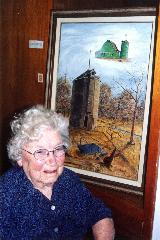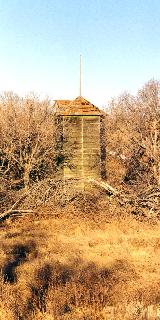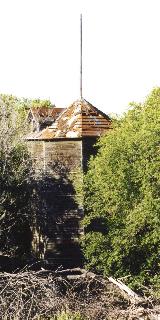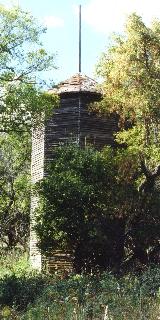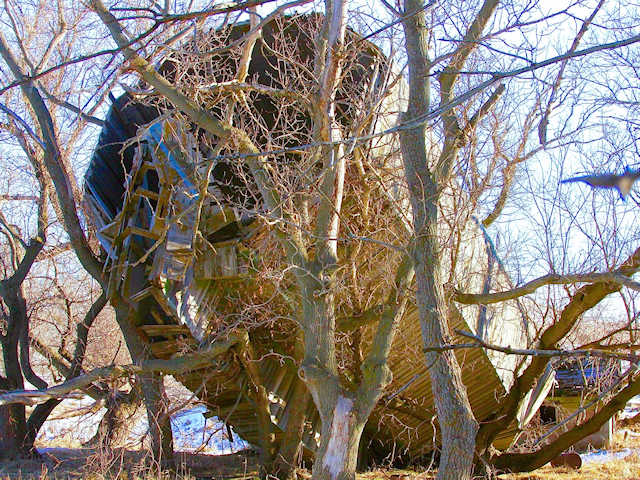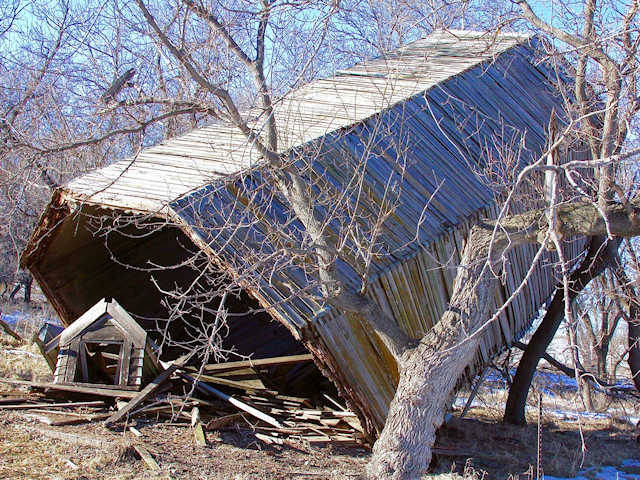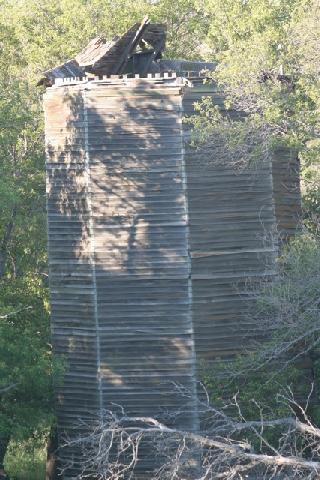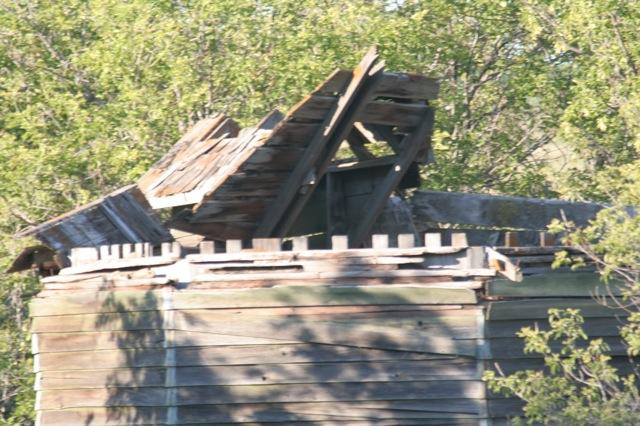My husband and I were out driving around one Sunday afternoon looking at old farm buildings. As we approached a low-lying area with a lot of trees (called a “coulee” in this area) we noticed a tall wooden pole rising well above the trees. I knew there was something interesting in there that I would want to see.
We didn’t stop that day, but after passing the spot several more times, we did finally stop and walk into the trees to investigate. We knew who owned the land and also who leased it and figured they wouldn’t mind.
We climbed over the fence and walked through the tangled trees to where the farmstead had once been. The house was razed a long time ago; there’s still a small dilapidated building next to where it stood.
When we looked inside the small building, we saw that it had three sections. One section had been a pretty nice two-seater outhouse, with one seat lower than the other to accommodate kids. The other sections of the building were used for storing coal and corncobs.
Beyond the nearly vacant farmyard were a stream and the footings for a bridge. Etched in the concrete on one footing was “March 21, 1916”.
Just beyond the creek, in among the trees, loomed a huge octagonal silo made of wood. On its top was the pole we had seen from the road. I was quite moved by coming across this abandoned giant. My husband and I went back several times to look at the silo, take pictures, and study how this amazing structure was made.
We had been told that the old barn was moved to another farm many years ago, but when my husband and I went looking for it, we couldn’t find it.
Silo Stands Alone
My husband’s family has farmed in these parts for many years and from them I learned some of the history of the farm known as “Pattie’s Coulee” located about 10 miles south and east of Britton, S.D. I also learned about Pattie’s Coulee from The Marshall County History Book.
The real treasure trove of information, however, was a wonderful woman named Isabel Pattie Fryer. Now 95 and living in a nursing home, Isabel was 8 or 10 years old when her father, Charles “Carl” Pattie, had the silo built. She isn’t sure of the date, but it must have been a little before 1918. Isabel also solved the mystery of the pole on top of the silo. “It was a flagpole.” she said. In Carl Pattie’s time, the Stars and Stripes flew proudly above the silo!
I don’t know how many silos like this there once were. I do know there aren’t many standing today. I’ve spent a lot of time wandering around the silo, studying its construction and trying to understand everything about it.
Pieces of it are scattered on the ground, and there are gaping holes in its roof and sides. Nonetheless, there’s more than enough of it left to see the care and craftsmanship that went into building it. |
|
Captured On Canvas
While I was gathering facts, I also made an oil painting showing how the silo looked when it was built and how it looks now. Isabel helped me with that, making sure I got the details right on both the silo and the barn to which it was attached.
All the buildings except the house were green. Because most farm buildings hereabouts are red or white, I asked Isabel, “Why green?” Her answer: “Well, why not green?”
Then Isabel had a question for me: “Why would anyone be interested in that old silo anyway?” I came up with several reasons: Its sturdy construction is something to appreciate and marvel at...the way it has resisted the ravages of time and weather makes it seem kind of noble...and then the fact that something so well-made could fall into disuse makes you sad.
There isn’t much I can do for the old silo other than tell its story. I also hope folks who know about other woodstave silos – especially ones with eight sides – will write Farm & Ranch Living magazine and tell about them.
Isabel still owns the farm, though she leases out the land. Her father bought the farm, then known as the Glen Una Ranch, in 1902, when he was about 25. Born in Maine, his ancestors emigrated from England to this country in the 1600’s.
Carl Pattie erected the buildings on the farm and painted them green. The barn, which faced west toward the house across the creek, had a lean-to on each side. The silo, the same height as the barn, was attached to the south lean-to.
About 40 feet high and 48 feet in circumference, the silo has a concrete foundation and floor. The sides consist of three layers of wood. The inside wall is made of vertical one-by-four tongue-in-groove redwood boards, most 20 feet long.
The middle layer has two-by-fours stacked on top of one another like a pile of lumber. After every seventh two-by-four, there’s a two-by-six. The redwood boards of the inner wall are nailed to the two-by-sixes.
Awesome Structure
The boards of the middle wall are beveled and staggered at each of the eight corners. I assume – but cannot tell for sure – that there are fewer two-by-sixes nearer the top where the outward pressure would have been less.
The outer wall is composed of one-by-six siding, and there is tin flashing covering the eight corners. The roof is one-by-tens overlapped to allow ventilation but prevent moisture from getting inside. The enclosed ladder chute has 10 doors that pivot and slide inward, providing access to wherever the top level of silage was. Once open, the doors fit flush against the inner wall.
Standing inside this tall chamber, you can’t help but admire the stately beauty of the woodwork – it’s a truly awesome structure! |
